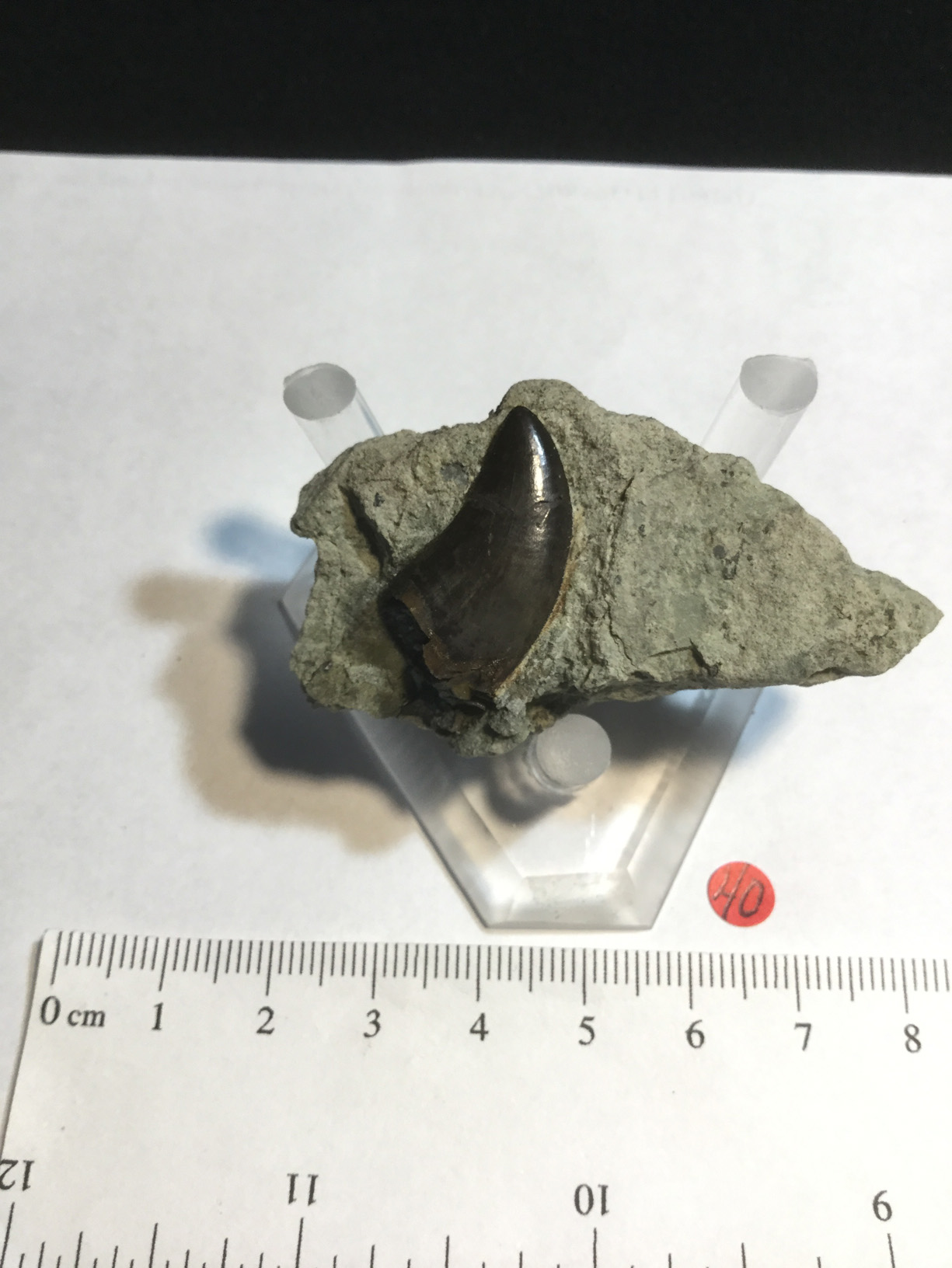
Jurassic Morrison Raptor Tooth
Sorry, this item is no longer for sale
Raptor Tooth aff. Coelurosaur
Morrison Formation
Upper Jurassic
Moffat County, Colorado
Sold Ryan Cieszkowski
Morrison Formation
Upper Jurassic
Moffat County, Colorado
Sold Ryan Cieszkowski
This tooth is an excellent example of a Morrison raptor. It is 3 cm long and has excellent serrations from tip to gum-line on both tooth edges. The tooth has excellent preservation and is not crushed or distorted. The only restoration is the filling of a minute single natural fracture. The specimen is prepared in its original matrix.
Coelurosauria meaning hollow tailed lizards is the clade containing all theropod dinosaurs more closely related to birds than to carnosaurs. Coelurosauria is a subgroup of theropod dinosaurs that includes compsognathids, tyrannosaurs, ornithomimosaurs, and maniraptorans; Maniraptora includes birds, the only dinosaur group alive today. Most feathered dinosaurs discovered so far have been coelurosaurs. Philip J. Currie considers it probable that all coelurosaurs were feathered. In the past, Coelurosauria was used to refer to all small theropods, although this classification has been abolished.
The phylogeny and taxonomy of Coelurosauria has been subject to intensive research and revision. For many years, Coelurosauria was a 'dumping ground' for all small theropods. In the 1960s several distinctive lineages of coelurosaurs were recognized, and a number of new infraorders were erected, including the Ornithomimosauria, Deinonychosauria, and Oviraptorosauria. During the 1980s and 1990s, paleontologists began to give Coelurosauria a formal definition, usually as all animals closer to birds than to Allosaurus, or equivalent specifiers. Under this modern definition, many small theropods are not classified as coelurosaurs at all and some large theropods, such as the tyrannosaurids, were actually more advanced than allosaurs and therefore were reclassified as giant coelurosaurs. Even more drastically, the segnosaurs, once not even regarded as theropods, have turned out to be non-carnivorous coelurosaurs related to Therizinosaurus. Senter (2007) listed 59 different published phylogenies since 1984. Those since 2005 have followed almost the same pattern, and differ significantly from many older phylogenies.
Coelurosauria meaning hollow tailed lizards is the clade containing all theropod dinosaurs more closely related to birds than to carnosaurs. Coelurosauria is a subgroup of theropod dinosaurs that includes compsognathids, tyrannosaurs, ornithomimosaurs, and maniraptorans; Maniraptora includes birds, the only dinosaur group alive today. Most feathered dinosaurs discovered so far have been coelurosaurs. Philip J. Currie considers it probable that all coelurosaurs were feathered. In the past, Coelurosauria was used to refer to all small theropods, although this classification has been abolished.
The phylogeny and taxonomy of Coelurosauria has been subject to intensive research and revision. For many years, Coelurosauria was a 'dumping ground' for all small theropods. In the 1960s several distinctive lineages of coelurosaurs were recognized, and a number of new infraorders were erected, including the Ornithomimosauria, Deinonychosauria, and Oviraptorosauria. During the 1980s and 1990s, paleontologists began to give Coelurosauria a formal definition, usually as all animals closer to birds than to Allosaurus, or equivalent specifiers. Under this modern definition, many small theropods are not classified as coelurosaurs at all and some large theropods, such as the tyrannosaurids, were actually more advanced than allosaurs and therefore were reclassified as giant coelurosaurs. Even more drastically, the segnosaurs, once not even regarded as theropods, have turned out to be non-carnivorous coelurosaurs related to Therizinosaurus. Senter (2007) listed 59 different published phylogenies since 1984. Those since 2005 have followed almost the same pattern, and differ significantly from many older phylogenies.





